Evercreech Park

A drawing of Evercreech Park House, from the current owners of what is now
called Evercreech Park Farm.
The inscription at the bottom of the picture says "The South East View
of Evercreech Park House, Somerset. Built by Sir Ralph Hopton, 1609"
The artist's name may be J. Backler and the date (also very indistinct) appears
to be 1922, but may be 1822.
Evercreech Park was purchased from Messrs Tretheroy and Caryll by a Richard
Newman in 1657 according to a purchase
contract given to me by the current owners of Evercreech Park Farm. Thie
purchaser must have been Richard Newman (d.1695) who would
have been 37 at the time, since he is described as resident in the City of Westminster.
Three of Richard Newman's children appear to have been born at Evercreech Park
so presumably he took up residence there after his marriage, when Fifehead was
still occupied by his father.
By 1675 Richard seems to have entered into a lease agreement with his brother-in-law
the Hon. William Harbord of Perry Park, Northampton;
Sir Francis Hollis of Winterborne St Martin, Dorset; Sir William Pargiler of
Greedworth, Northampton; and William Tate of De La Pre also of Northampton,
whereby "in consideration of the sum of five shillings of lawful English
money to him in hand" Col Richard handed over possession for a period of
12 months of Evercreech Park ("two hundred and twenty acres more or less")
and several other nearby estates. A copy
of the lease (itself a copy made in 1779) was given to me by the current
owners of Evercreech Park Farm. It is interesting to list the other lands and
rights therein said to be owned by Richard Newman. These include -
- lands [etc] of the said Richard Newman which he lately purchased
off Stanton in the Parish of Glaston, Somerset
- lands [etc] called Oxen Leaze in the Parish of Wincanton, Somerset
now in the possession of Roget Greene containing sixty acres more or less
- fee farm rents ... payable out of the Manor of Ditcheat, Somerset lately
purchased by Richard
- farm called Cole Street Farm in the parish of Easlower, Dorset ... conteyning
three hundred acres more or less and is now in the possession of William Rake
- fee farm rent of twenty eight pounds three shillings and seven pence payable
out of the manor of Stalbridge, Dorset lately purchased by Richard Newman
- fee farm rents aforesaid and all that the manor of Weslower als Lower Weslower,
Dorset
- that pasture and meadows ground called Popes Ham and Salt Mead
- all that meadow and pasture called Newmans ham als Hamm Wood and the Meadow
thereunto adjoyneing
- all that pasture ground called Hill Close and the parcel of Meadow thereunto
adjoining, situated in the Parish of Stallbridge Dorset.
Evercreech Park passed through four generations of Newmans, starting with Richard
Newman (d.1695) [see note below], his eldest son, Richard
Newman of Evercreech, thence Sir
Richard Newman of Fifehead, Preston Hall and Evercreech, and finally to
Sir Samwell Newman. On Sir Samwell's death,
the estate came into the administration of his sister Frances Newman on whose death its fate remains
uncertain. On the one hand, Frances's
almost incomprehensible will (dated the year of her death in 1775) includes
two referneces to Evercreech - in the first instance, she left £10 to
the poor of the village and in the second instance she left "all my Messuages
Lands Tenements and Hereditaments called Evercreech Park in the said County
of Somerset .... unto the said Sir James Langham his Heirs Executors Administrators
and Assigns ... ". On the other hand, 'The History and Antiquities
of Somerset' by John Collinson 1791 (see extract below) reported that Evercreech
Park remained in the Newman family "till the year 1773, when it was purchased
by Thomas Sampson, esq; the present possessor." Either way, it appears
that the estate remained under Newman ownership for around 150 years.
Note:
in
the 1693 codicil to his Will, Richard (d.1695) made no mention
of Evercreech Park. However his son (Richard
d.1682), who predceased him, left a Will
dated 1691 in which he left Evercreech Park to his son (Sir
Richard Newman). Presumably Richard (d.1695) gifted Evercreech Park to his
son before 1681.
Ian Caldwell tells me (June 2003) that the original house was demolished around
1840 when it was replaced with the present building. Evercreech Park Farm as
it is now called is a couple of miles out on the southwest side of the village.
It retains two features from the old house - the main fireplace which is now
located in the kitchen, and the garden gate (seen in the illustration above)
which, together with a section of stone wall, is still extant at the bottom
of the garden (as illustrated in the photos below)
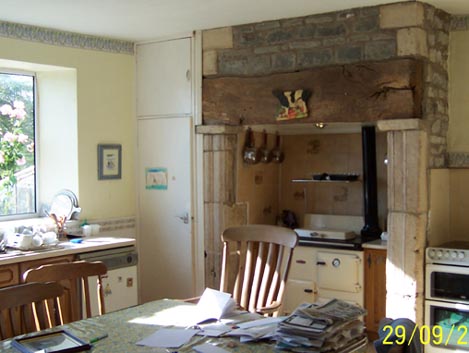
The kitchen fireplace is clearly from the old house (see picture below)

The garden gate is also clearly from the old house, and even incorporates
the same broken-down bit of stone wall beside it.
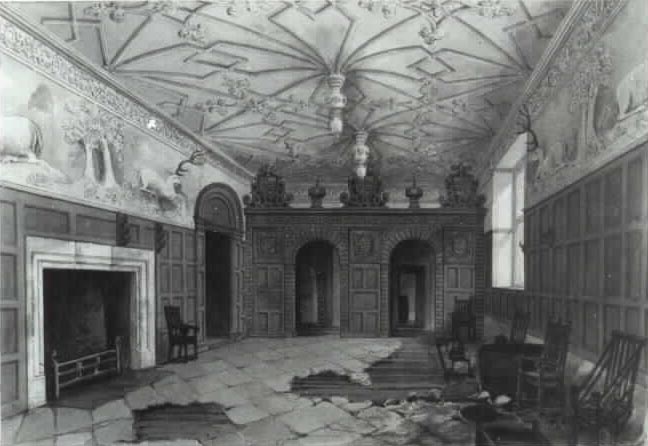
Interior of Evercreech Park House
The fireplace on the left is now part of the kitchen of Evercreech Park Farm
as shown in the photo above.
See also the note below relating to the deer's
antlers.
The ornate plaster ceiling is remeniscent of the main bedroom ceiling at Cadbury
Court.
Di Clements (professional researcher)
discovered the following information and maps about Evercreech Park for me:
1: The following is taken from D/P/eve 23/1
History of Evercreech by the Rev. Prebendary Jenkins Vicar. He notes that Raffe
so Robert Hopton Esq was bapt. 1596 and three years later Jane da Worshipful
Mr Robert Hopton. He writes of the incumbents, one James Dugdale "In the
beginning of the Wars [Civil War], attending on Lady Hopton w.o. my Lord Hopton,.....
as spiritual assistant on her Death Bed, he was taken prisoner and carried to
London and kept close two weeks." and of the church he says that in its
original state it "had but one aisle until the Possessor of an Estate called
Evercreech Park made an additional building of no great beauty on the South
aisle which is called Park aisle"
The Park: In or near Southwood is a large stone edifice in which was
born Robert Hopton. Whether he built it is uncertain it is probable however
only half was erected by him. The initials RH are on the portico which is
constructed in three orders of Grecian architecture ascending from the ? .
this portico seems not to have been part of the original plan of the House
being in all probability added to render the House warmer by breaking the
force of the wind. The Date 1617 thereon is a clear proof of its being posterior
to the inner rooms which bear the date 1609 and 1613 whence we may conclude
the Hall was finished 1609 the Drawing room 1613 and the Portico 1617.
You enter the House by an ascent of 8 steps, on the right hand was the Buttery
separated from a large spacious Hall of 38 by 20 [ft?] by a wooden skreen
of oak whereon are carved Escutchions of Arms, the device of the Hop Bind
growing out of a tun. It is paved with Freestone till within a few Feet of
the upper End where it is floored with oak. The Wainscot which is also of
oak reaches to 7½ ft the remainder is finished with Stag's Heads and
Trees in Plaister work and the Hop growing out of the Tun; at the upper end
is a spacious stair case leading to a roomof the same dimension as the Hall
and passage below.This is also wainscotted in small panels with Oak with the
conceit of the hop intermixed with escutcheon in the Plaister work by way
of Corniche. The Ceiling is ornamented with Figures of various animals in
Compartments. Over the two doors are the Arms of Hopton impaled with those
of Hall and Capel.
Over the fireplace are collected and emblazoned in one Escutcheon the Arms
of Hopton and most of the others which are carved on the wooden skreen below
with the Crest of Hopton, a Griffin holding in his dexter claw a stone sa.
on the dexter side and a Unicorn armed and crined on the sinister sejant gulle
de sang.
The Park was sold to R Newman
of Fifehead Magdelane 1653 Resident 1657. Married first Elizabeth do Giles
Simmons second Elizabeth do Christopher Penny /Perry of Ken, Somerset by whom
came Richd N who m.
Ann do Sir C Harboard Kt.[?] Created Sir
Richard Dec.1699 m Frances do Sir T Samwell, Upton of Northants from whom
descended Sir Samwell N who died
unmarried 174- Two sisters - Elizabeth
m Kitchener of Westminster an Apothecary who died 1765. In 1764 an Act passed to empower a Committee
of the estate of Elizabeth K wid lunatic, one of the heirs of Sir Samwell
N to make leases during her lunacy."
[History of Evercreech compiled by the vicar, Rev. Preb. Jenkyns c.1810.
From Somerset Records Office D/P/eve.23/
Some of the above information is incorrect. For instance, it appears
the Richard Newman purchased Evercreech Park in 1657 and not 1653. Also it was
Frances, and not Sir Samwell who was empowered to administer Elizabeth's estate.
Elizabeth's husband died in 1753 and the Act was passed in 1754 - see notes
on Frances Newman's page. Quite possibly therefore, Jenkins may also be mistaken
as to which Richard Newman purchased Evercreech Park)
Note 2: Again from Di Clements:
"The old park of the Bishops called Evercreech-Park, is situated at
the south-west extremity of the parish, bordering on the parishes of Ditchet
and East-Pennard. It was formerly empaled but is now divided. In the centre
of the estate, and nearly on the site of an old court-house erected by Ralph
de Salopia, and ruinated in the time of Henry VII. is a very strong mansion,
built in 1613 by Sir Ralph Hopton, afterwards created Lord Hopton, baron of
Stratton in Cornwall. The house has undergone little or no alteration, but
appears as originally fitted up. There is a large hall divided from the entrance
by a handsome screen, which is ornamented with the device of Hopton, viz.
hops issuing from a tun, and the arms of Hopton, Wyndham, Maltravers, Mompesson,
Throgmorton and other families. The dining-room over it is decorated in the
same manner. At the top of the house there is a gallery running the whole
length of the building, apparently intended as for a banqueting room. During
the usurpation this estate was confiscated for Sir Ralph Hopton's supposed
treasons (as described in a separate page dedicated to Sir
Ralph Hopton), and was sold in 1653, by the commissioners appointed by
parliament to sell forrfeited estates, to John Caryll and John Trethery, who
sold it four years after to Richard Newman, esq, (Richard
Newman of Fifehead) whose family remained till the year 1773, when
it was purchased by Thomas Sampson, esq; the present possessor." [Extracted
from 'The History and Antiquities of Somerset' by John Collinson 1791].
Note 3: Di Clements sent me the following in Aug 2002:
"A/AQP 34 Rack's notes. He was helping Collinson with his history, the
notes are fuller but repetitive. On the south side of the parish a large stone
mansion built 1614 by Lord Hopton as appears by the initials RH and the Hopton
Arms on the Portico. It was formerly enclosed with a Park, as were many -
see in Cambdon's map of this County, but is now converted into a Farm though
it still retains the name of Evercreech Park. It is the property of Mr Sampson
of Bruton by purchase. Against the walls are deer formed in plaster with real
horns on their heads. Over the Hall -a large dining room with Portales, Chimney
and ceilings ornamented with the same device. There is a gallery on the top
of the house, the whole length of it, which from the ornaments and manner
of its fitting up, seems to have been the Ball or Banqueting room. During
the Usurpation this estate was confiscated for Robert Hopton's supposed treason
and sold in 1653 by Parliament and was sold 4 years after to Richard Newman
Esq. in whose family it remained to 1778 when purchased by Thomas Sampson."
This extract can be viewed on-line on pages 414 - 415 of the
above source.
The map of Evercreech Park Farm (below) was also found by Di Clements. The
map is dated 1831 and shows it owned by Mesdames Ward and White. It is described
as as 225 acres in the south of the parish. Below it are a close-up detail of
the map and the legend. Below that is a parish map showing the location of the
farm relative to the Shepton Mallet - Castle Cary road and a road map showing
its approximate location.
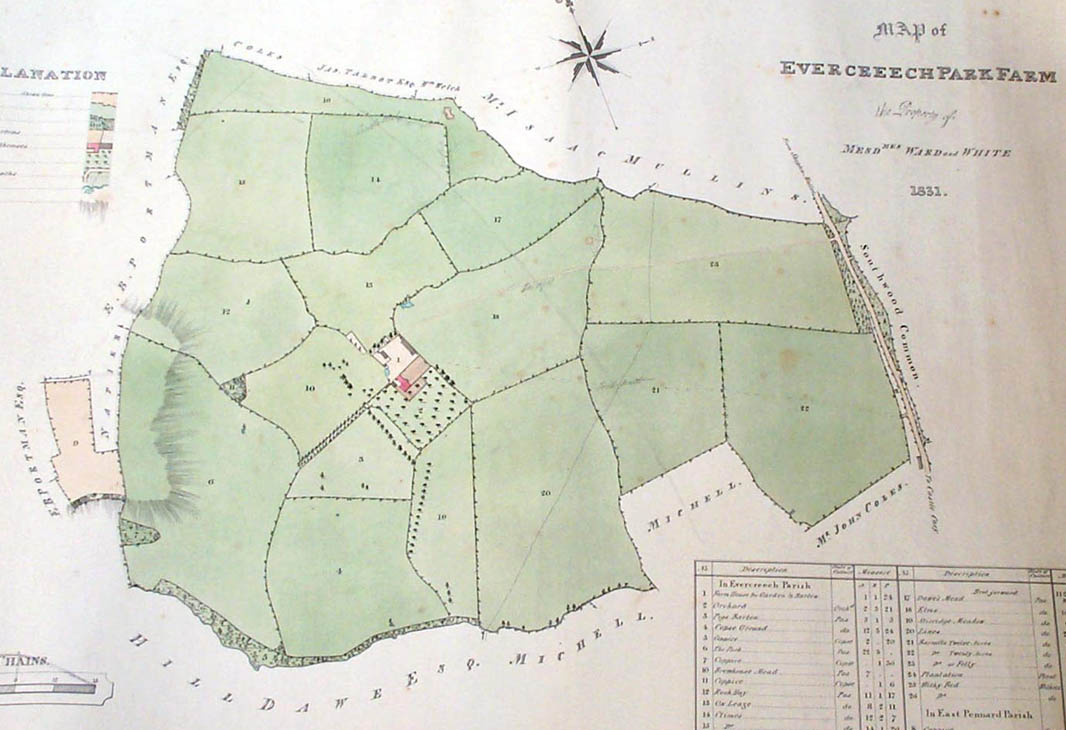
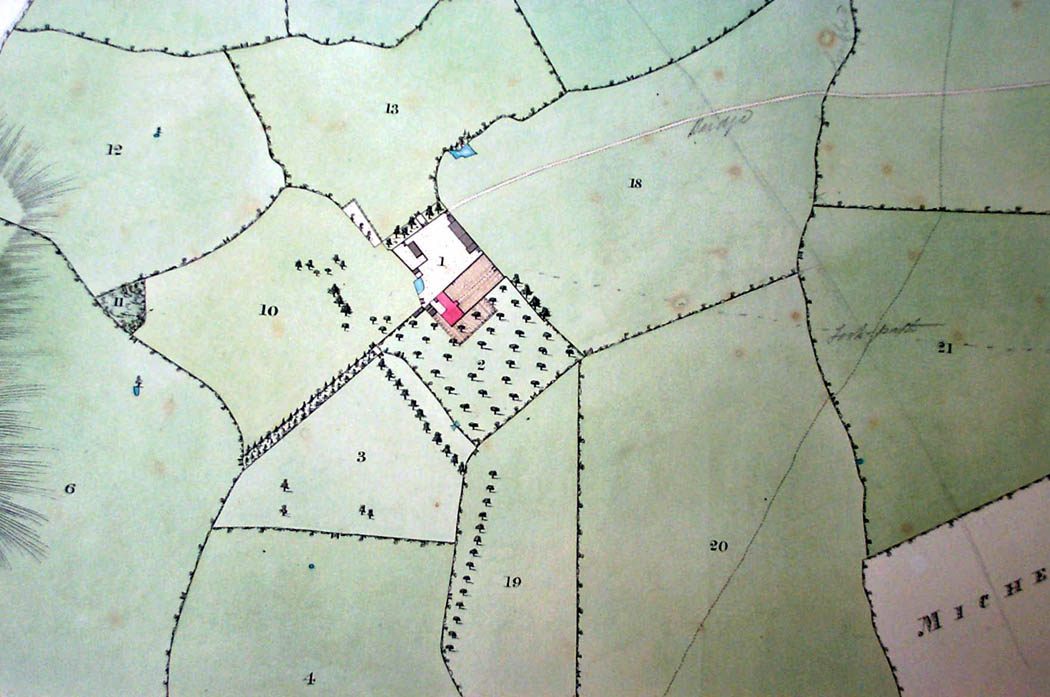
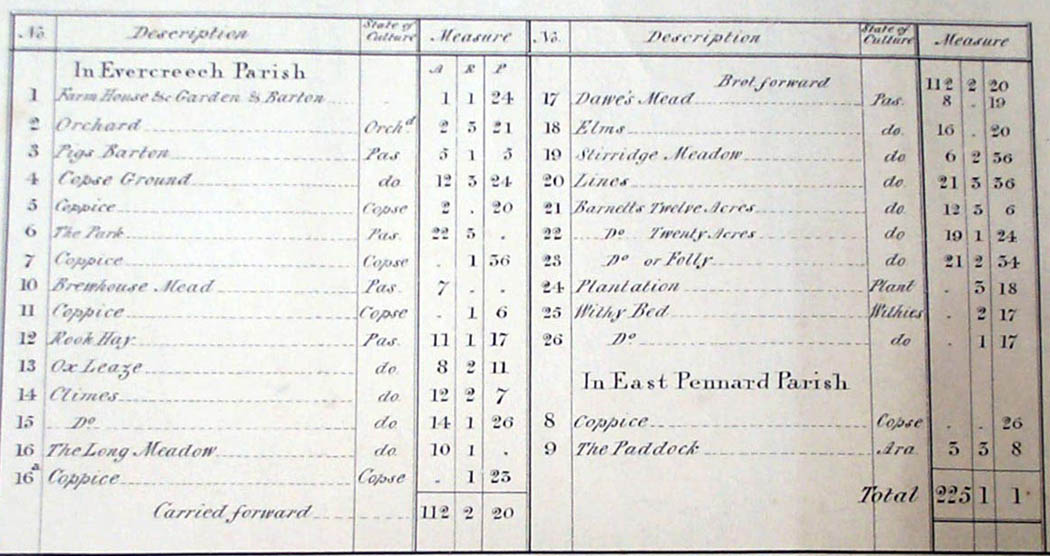
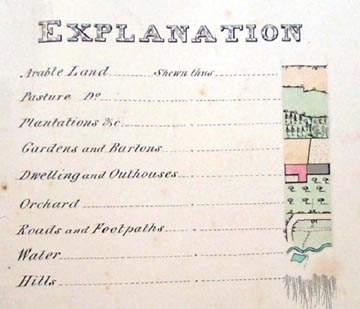

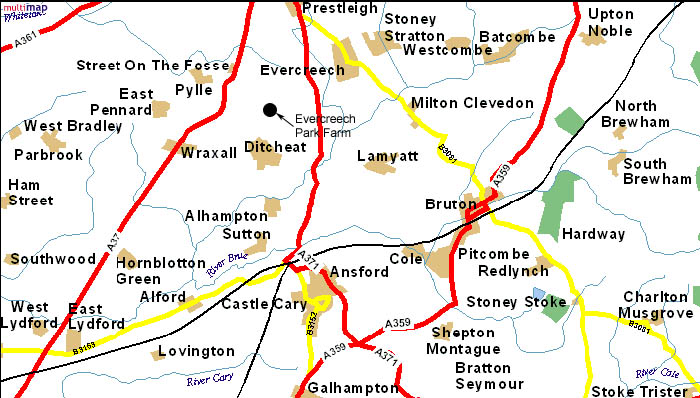
Evercreech itself is an enchanting and quite unspoilt Somerset village with one
of the loveliest of English parish churches, and is quite famous for its high
bell tower. For me though, Evercreech was something of a mecca in my childhood
that seemed only to be able to be reached by taking the train to the end of old
Highbridge Branch.of the Somerset and Dorset Joint Railway. Evercreech Junction
was where the branch line met the "main" line between Bath and Bournmouth
via Templecombe, and my recollections of it (and Templecombe) were that they were
very important and busy centres. Too late I discovered that it was actually within
quite easy cycling distance, and by 1966 the line was closed and has now all but
disappeared. Revisiting these places as an adult reveals them to be small and
very quaint villages which without the old railway have lost something of their
magic.
By coincidence, my step-mother Patricia was brought
up in Evercreech, as described briefly on her page of this tree.
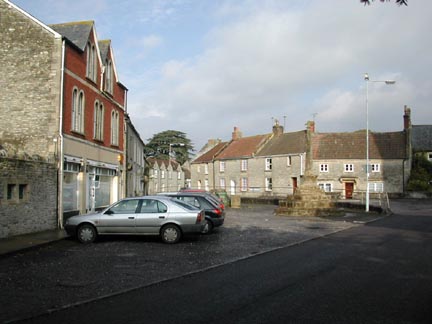
Evercreech Village Square, opposite the church

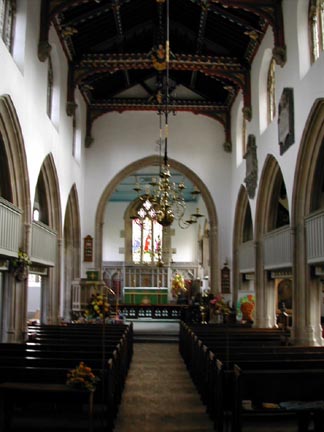
The beautiful Parish Church at Evercreech - one of the finest in England
Note: Di Clements told me in Oct 2003 that she had discovered in the church
at Evercreech on a plain blue stone let into the west wall of the Park aisle:
Memoria Sacrum
Grace Newman aged 12 months buried October 9
Henry Newman aged 9 weeks buried February 5
Anno MDCLXXX [1553 year ends March 21]
"As Parents Grief the
Children's Joy so Earth
To Heaven is a Toy"
I have discussed this finding at greater length in Note 5 under Richard Newman of Evercreech.
Last updated: 11th Aug 2020 - ownership updated based on information
from Harold Biggs
Updated: 8th Feb 2011 - reference to Frances
Newman's Will added




